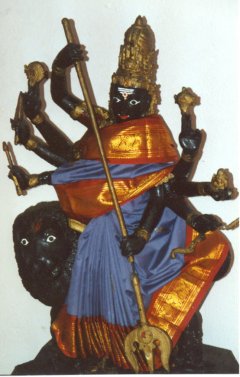



Image
used with permission.
Basic Description: the unfathomable one, the goddess beyond
reach. She is a fierce, aggressive goddess. Durga is celebrated for her killing
of Mahisasura. Mahisasura
or Mahisa is a buffalo god/demon (symbol of death) who is still worshiped in
S. India, as Potu Raja, the Buffalo King. She destroys the demon of ignorance,
nourishes the poor, and confers blessings of love and knowledge upon all who
strive for God-realization.
Alternate Names: Durga is also known in different
forms: in milder forms she is Parvati, Uma, Himavati, Gauri, Mata, Jagatmata, and
in her terrible forms as Kali or Shyama, Bhavani, Chandika or Chandi, and Lalitha.
Generally speaking she is known as Devi or Mahadevi (the great goddess).
History/Practices:
One of the oldest and most widely used names for the Divine
Mother. She is worshiped in two great annual festivals. The Durga-Puja festival held in Bengal is particularly devoted to
Durga. This festival is held in the fall and lasts no less than five days.
It typically opens with an invitation to call Durga from her heavenly
realm. On the last day of the festival, the image of Durga that has been
fashioned for the occasion is lowered into a river or the sea.
Iconography:
Her ten-armed figure, standing on the back of a lion is meant to symbolize
the great power that the Vedic texts describe her as wielding, either to punish
or to confer grace on human beings.
Mythology:
The following is probably the most important myth associated with the
goddess Durga:
Mahishasura, the king of Asuras, through years of austerities,
was once granted a boon by Brahma, that no man or deity would be able to
kill him. The immense power filled in him the urge to rule over the world. He
started to terrorize heaven and the inhabitants. He pervaded the world with
his battalion of Asuras and plundered and ruthlessly killed the people. Chaos
and anarchy reigned. Gods were driven from heaven and Mahishasura usurped the
throne. The Gods were scared and unable to combat him, so they requested
Shiva, Brahma, Vishnu to stop Mahishasura's tyranny. In answer,
the three Gods combined their divine energy and summoned up a feminine form
so brilliantly glaring that it illuminated the heavens. From the glow emerged
Devi Durga, a beautiful yellow woman with ten arms riding a lion. Despite her
grace she bore a menacing expression, for Durga was born to kill. Fully grown
and beautiful Durga was immediately armed by the gods and sent forth against
Mahishasura bearing in each of her ten hands, symbols of their divine power.
Vishnu's discus; Shiva's trident; Varuna's conchshell; Agni's flaming
dart; Vayu's bow; Surya's quiver and arrow; Yama's iron rod; Indra's thunderbolt;
Kubera's club and a garland of snakes from Shesha and a lion as a charger from
Himalayas. A fierce battle took place. Finally when Mahishasura in the guise
of a buffalo charged against Durga, the Devi beheaded the buffalo and from it
emerge Mahishasura in his original form. Durga pierced his chest with the trident
before he could get away and relieved the world from the evil power. That is
why she is the mother goddess who destroys the evil, protects her devotees and
establishes peace and prosperity on earth.
Riding Animal: Durga’s riding animal is the
lion.
Consort:
Durga is one of the shakti of Shiva.
Sources:
Dani é lou, A. The Myths and Gods of India.
Inner Traditions International. Rochestor, Vermont. 1991.
Knipe, David M. Hinduism: Experiments in
the Sacred. Waveland Press, Inc. Prospect Heights, Ill. 1991.
Schuhmacher S. and Woerner G. The Encyclopedia
of Eastern Religion and Philosophy. Shambhala Boston, Mass. 1989.




